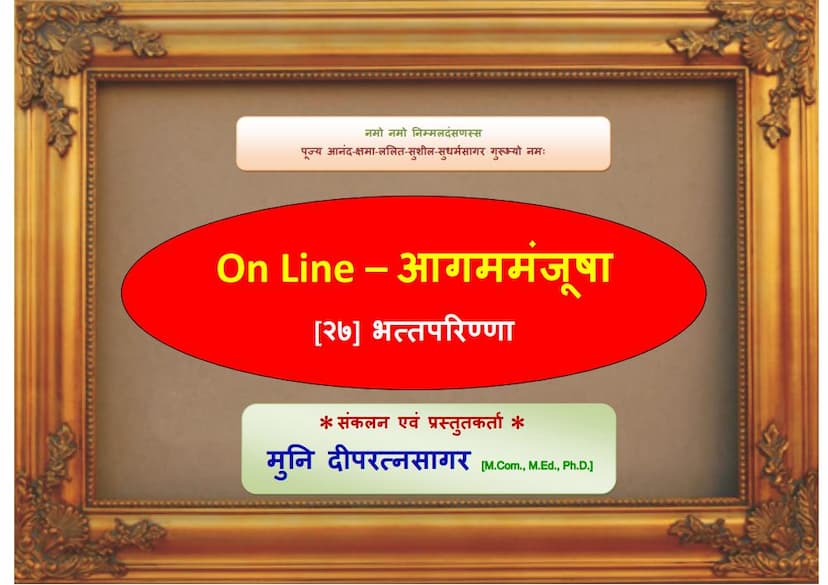Aagam Manjusha 27 Painnagsuttam Mool 04 Bhattparinna
Added to library: September 1, 2025

Summary
Here's a comprehensive summary of the Jain text "Aagam Manjusha 27 Painnagsuttam Mool 04 Bhattparinna," based on the provided pages:
Title: Aagam Manjusha 27 Painnagsuttam Mool 04 Bhattparinna (Book 27, Chapter on Bhaktaparinnā)
Authors: Anandsagarsuri, Sagaranandsuri (as editors/presenters)
Publisher: Deepratnasagar
Overview:
This document is a Jain religious text, specifically the Bhaktaparinnā chapter from the Painnagsuttam (a collection of supplementary or miscellaneous scriptures in Jainism). The text focuses on the concept of Bhaktaparinnā, which translates to "death achieved through devotion" or "death by consecration/dedication." It outlines the principles, practices, and significance of achieving a conscious, purposeful, and spiritually motivated death.
Key Themes and Concepts:
- Bhaktaparinnā as a Path to Liberation: The core message is that a death consciously embraced with a devotional mindset can lead to spiritual liberation (moksha). It is presented as a noble and praiseworthy way to end one's life, particularly for those who have dedicated themselves to spiritual practice.
- Importance of Right Faith (Samyaktva): The text repeatedly emphasizes the foundational role of "samyaktva" (right faith or correct perception) in achieving liberation. Without right faith, even great austerities or devotion might be futile.
- The Value of Human Birth and Jain Teachings: It highlights the rarity and preciousness of human birth and the opportunity to encounter Jain teachings (Jinvachan). Those who have attained this combination are urged to strive for spiritual progress.
- Dispassion and Renunciation: A significant portion of the text discusses the need to cultivate detachment from worldly pleasures, desires, and attachments. This includes renouncing sensory enjoyments, anger, pride, deceit, greed, lust, and all forms of passions.
- The Role of the Guru: The text underscores the crucial role of a Guru (spiritual preceptor) in guiding the disciple through the process of preparing for and undertaking Bhaktaparinnā. The Guru's approval, guidance, and teachings are essential.
- Practices Leading to Bhaktaparinnā:
- Alochana (Confession): A sincere confession of faults to the Guru is a prerequisite.
- Prayaschitta (Atonement): Performing atonements prescribed by the Guru is necessary.
- Renunciation of Food (Ahar Tyag): The practice of gradually renouncing food, starting with the three types of food (food, drink, chewing substances), is described. This is presented as a means to purify the body and mind.
- Samayika and other Vows: Adherence to vows like Samayika (equanimity) and the five great vows (Panch Mahavratas) is important.
- Mindfulness and Meditation (Dhyana): Cultivating mindful awareness and engaging in meditation is crucial for maintaining equanimity and focus.
- Forgiveness (Kshama): Seeking and granting forgiveness from and to the community (Sangha) is an essential part of the purification process.
- Types of Bhaktaparinnā: The text mentions two types:
- Savichara (with contemplation): This involves conscious contemplation and planning.
- Avichara (without contemplation): This is a more spontaneous state, achieved through advanced spiritual development.
- Obstacles and Pitfalls: The text warns against attachments, worldly desires, and negative emotions like anger, pride, deceit, and greed, which can hinder spiritual progress and the attainment of Bhaktaparinnā. It specifically highlights the dangers of attachment to women and sensual pleasures.
- The Power of the Namokar Mantra: The text repeatedly emphasizes the immense power of the Pancha Namaskara mantra (Namokar mantra) in overcoming obstacles, achieving liberation, and purifying oneself, even at the time of death.
- Importance of Non-Violence (Ahimsa): Ahimsa is presented as the highest form of dharma. Causing harm to any living being is considered detrimental to oneself.
- The Nature of Worldly Suffering: The text vividly describes the suffering inherent in the cycle of birth, old age, and death (samsara), characterized by disease, pain, and impermanence. This understanding fuels the desire for liberation.
- Ethical Conduct: The text stresses the importance of truthfulness, honesty (not stealing), celibacy (Brahmacharya), and righteous conduct.
- The Cycle of Karma: The text alludes to the impact of past karma and the need to purify oneself from karmic impurities to achieve liberation.
Structure and Presentation:
The text is presented in verses (gathas) and appears to be written in an ancient Prakrit or Apabhramsha language, with annotations or explanations likely in Hindi or Sanskrit by the editors. The content is didactic and devotional, aimed at guiding practitioners towards spiritual realization.
In essence, the "Bhattparinna" chapter of this Aagam Manjusha provides a detailed guide for Jain ascetics and devoted followers on how to consciously prepare for and embrace death with spiritual equanimity, devotion, and dispassion, ultimately aiming for liberation from the cycle of rebirth. It emphasizes the importance of the Guru's guidance, righteous conduct, detachment from worldly affairs, and the profound power of the Namokar mantra.